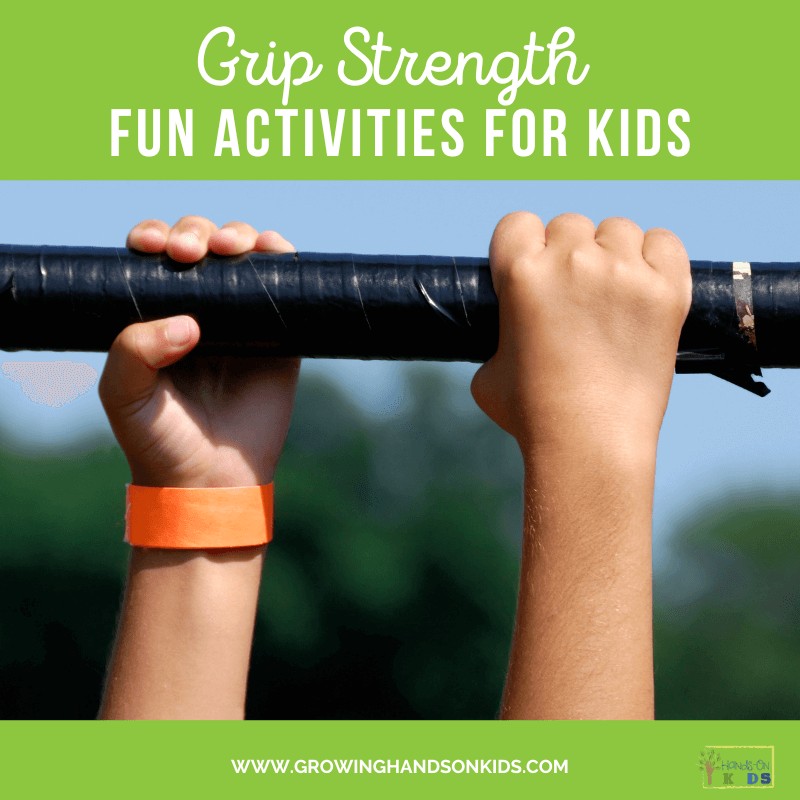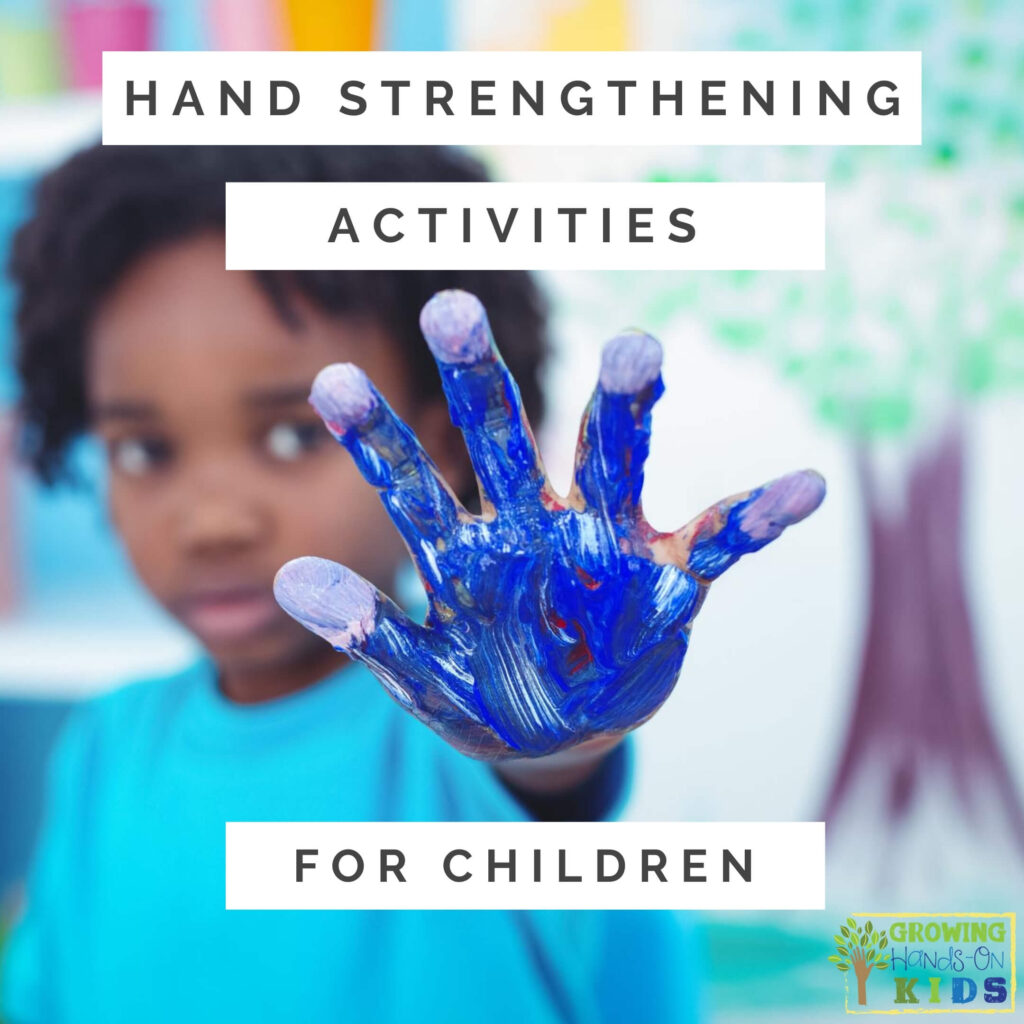Grip Strength: Fun Activities For Kids
Affiliate and Referral links are used below to promote products I love and recommend. I receive a commission on any purchases made through these links. Please see my disclosure policy for more details. As an Amazon Associate, I earn from qualifying purchases.
Building grip strength can be fun and easy … even if you're just a kid. To show you how I've created this list of activities that are great for kids. Plus we'll dig into why grip strength is important and some signs to look for if you think your child or student has weak grip strength.
Table of contents for grip strength
Why grip strength is important?
You may see grip strength referred to as hand strength. Basically, grip strength is the amount of force applied through the hand in order to grasp and grip objects. Grip strength can be measured by using a tool called a dynamometer. This measures the amount of force the hand is able to produce while gripping the handle and squeezing the hand.
Grip strength also refers to the entire hand while pinch strength is how much pressure is used between the thumb and index finger (sometimes the middle finger is used for support). You can read more about pinch strength here.
Occupational Therapists will often use a dynamometer when working with adults to measure grip strength for everyday activities.
For children, Occupational Therapists will look at how they are completing everyday tasks such as dressing, feeding, and academic activities such as handwriting.
What activities require grip strength?
Grip strength is needed for lots of everyday activities. Some of these include:
- Climbing
- Scribbling on paper with a crayon
- Playing with toys
- Buttons and zippers
- Cutting up food with a knife
- Opening and closing containers
Think of how many times you use your hands throughout the day, whether grabbing your cup of coffee in the morning or holding a pencil to jot down a note. As adults, we typically don't even think about how much pressure we need with our hands in order to grab something and hold it. You probably remember that feeling when you misjudge how much something weighs and you don't have a good grip on it when you go to pick it up.
How do I know if my child has weak grip strength?
The biggest indicator of weak grip strength would be difficulting with grasping and holding on to objects appropriately. Some of these signs may include:
- Difficulty grasping a pencil and holding on to it for handwriting
- Difficulty holding a knife or fork for self-feeding skills
- Not interested in fine motor activities, avoids them
- Switching hands often during writing activities (this is age-appropriate at times, see my post on hand dominance development for more information)
- Unable to grasp a zipper in order to zip up or down (see typical fine motor skills development for when to expect this skill)
- Difficulty with holding scissors for cutting activities
- Trouble opening and closing food containers such as unscrewing or screwing on a lid
- Frequently dropping items during everyday activities
- Holding an eating utensil with all their fingers
Which exercises improve grip?
There are about 30 hand muscles that must all work together in a very complex way in order to complete tasks. Improving muscle strength in the hands also includes addressing the arm and shoulder since hand muscles begin in the forearm.
There are many hand strengthener gadgets on the market, but for most children just providing lots of fine motor activities to help build their grip strength is sufficient, and more fun!
Let's take a look at some everyday play that can help build muscle strength in the palm, forearm, and shoulder.
Squeezing
There are so many creative ways to encourage your child to use their hands to squeeze. This includes squeezing play dough or modeling clay, spray bottles to clean windows or water plants, and juice from fruit such as lemons or oranges.
Squeezing bubble wrap, glue bottles, using a turkey baster to transfer water, or squeezing a sponge to wipe down a table or counter are other great options to incorporate hand strength.
Use a hole punch
You can use a hole punch to make dots or creative shapes for crafts. Here are some fun hole punch activities:
- Christmas Tree Hole Punch Activity from The OT Toolbox
- Hole punching fine motor activity from Days with Grey
- Free hole punch printable – the hungry monster from Your Therapy Source
Staple paper together with a stapler
Sit batter in a bowl for cooking tasks
Building with building blocks
Encourage your child to complete everyday dressing activities on their own
It is hard to remember this, especially when you need to get out the door quickly to be somewhere. If you find yourself doing a lot of your child's dressing such as zipping, buttoning, or tieing their shoes, make time in your day to practice these things without the pressure of having to be out the door.
Complete activities on a vertical surface
Drawing or coloring on a vertical surface helps to build the muscles of the arm and shoulder. Without the added support of the table, children can help build up the muscles of the shoulder and forearm, which is where the muscles of the hand begin.
Using tongs or tweezers to pick up objects
Hand-strengthening exercises or warm-ups before writing
I have another post on hand warm-up activities that you can find here.
Opening and twisting lids for jars or containers
What are some fun grip strength activities you have done in your home or classroom? Share them with us below in the comments.
References:
Alaniz ML, Galit E, Necesito CI, Rosario ER. Hand Strength, Handwriting, and Functional Skills in Children With Autism. Am J Occup Ther. 2015 Jul-Aug;69(4):6904220030p1-9. doi: 10.5014/ajot.2015.016022. PMID: 26114459.
Kadaskar V, Borkar T. A study to evaluate the correlation between pinch grip and handwriting among school going children in rural areas. International Journal of Research and Review. 2020; 7(2): 412-416.
Occupational Therapy – Kids health information – Hand and finger strength. 2005. © Department of Occupational Therapy, Royal Children’s Hospital, Melbourne.
Prunty MM, Pratt A, Raman E, Simmons L, Steele-Bobat F. Grip strength and pen pressure are not key contributors to handwriting difficulties in children with developmental coordination disorder. British Journal of Occupational Therapy. 2020;83(6):387-396. doi:10.1177/0308022619885046
You May Also Like:

Heather Greutman, COTA
Heather Greutman is a Certified Occupational Therapy Assistant with experience in school-based OT services for preschool through high school. She uses her background to share child development tips, tools, and strategies for parents, educators, and therapists. She is the author of many ebooks including The Basics of Fine Motor Skills, and Basics of Pre-Writing Skills, and co-author of Sensory Processing Explained: A Handbook for Parents and Educators.


